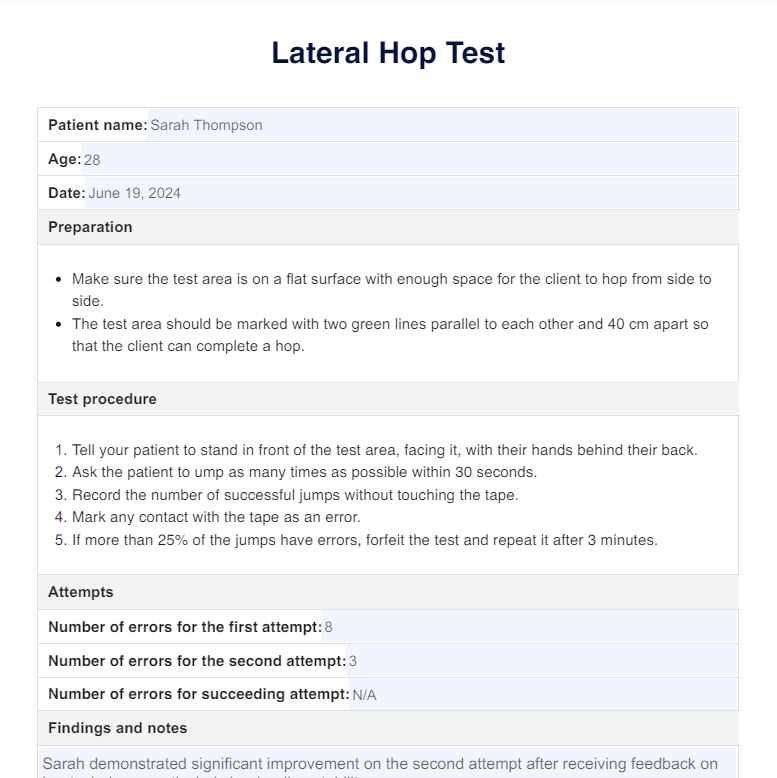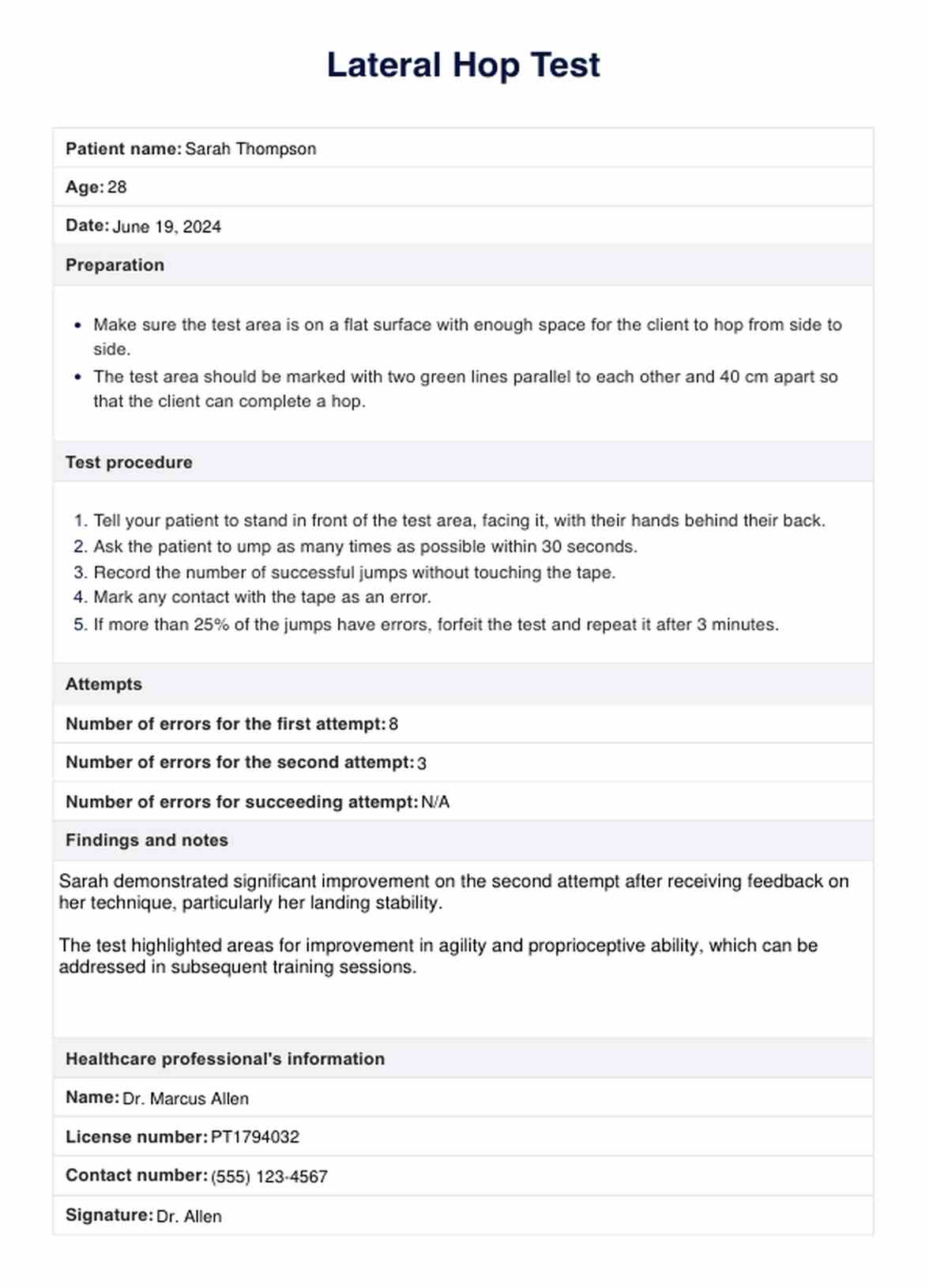Lateral Hop Test
Discover the Lateral Hop Test used to evaluate recovery from ACL injuries. Download our comprehensive guide and a free template to assess and enhance knee function post-injury.


What are anterior cruciate ligament (ACL) injuries?
Anterior cruciate ligament (ACL) injuries can manifest in several forms, depending on the mechanism of injury and the force involved. Here are some common examples:
- Non-contact injuries: These occur without physical contact with another player or object. It is common in sports like basketball, soccer, or skiing, where athletes change direction rapidly, causing the knee to twist and the ACL to tear.
- Contact injuries: Result from direct impacts to the knee, such as a tackle from the side in football or rugby. The impact force causes the ligaments, including the ACL, to stretch or tear.
- Partial ACL tears: The ligament is stretched and possibly partially torn but remains somewhat functional. Depending on the level of instability and the patient's activity level, these may be treated conservatively.
- Complete ACL tears: The ligament is completely torn, and the knee becomes unstable. These injuries often require surgical reconstruction to regain the full function of the knee.
- Combined injuries: Frequently, ACL injuries occur in conjunction with damage to other structures in the knee, such as the meniscus, medial collateral ligament (MCL), or cartilage. These are complex injuries that may necessitate a multi-faceted approach to treatment and rehabilitation.
Lateral Hop Test Template
Lateral Hop Test Example
What is the Lateral Hop Test?
The Lateral Hop Test is a functional performance test used primarily to assess an individual's ability to perform controlled side-to-side movements. It's particularly useful in the rehabilitation process following ACL reconstruction.
The test involves performing a series of single-legged lateral hops over a designated distance. The goal is to complete the set number of repetitions with proper form and control. The number of repetitions, hop height, or distance can be adjusted to fit the individual’s current ability level.
The test is one of several single leg hop tests, which also include the single leg hop for distance, the triple hop test, and the crossover hop. These tests collectively help in evaluating hop performance and leg muscle power, providing valuable data on an individual's functional capabilities.
The Lateral Hop Test and other hop tests are crucial in the context of anterior cruciate ligament injury and reconstruction. They offer insights into the recovery progress, particularly in relation to leg muscle power and the ability to return to dynamic activities.
How to use our Lateral Hop Test template
Our printable Lateral Hop Test template facilitates a systematic evaluation of knee function and rehabilitation progress, particularly following ACL reconstruction. This tool is especially useful for clinicians assessing recovery phases and planning subsequent interventions accurately.
- Download the template: First, download the Lateral Hop Test template from our website. This will ensure you have the correct format for recording and analyzing test results.
- Prepare the testing area: Set up the testing environment according to the specified requirements for conducting the Lateral Hop Test. Proper setup is crucial for accurate performance measurement.
- Conduct the test: Administer the test by having the patient perform repeated hops while closely monitoring and recording their performance on stability, hop counts, and symmetry of movements.
- Record the data: Use the template to log detailed test results, including any findings.
- Review and plan: Based on the analysis, review the recovery progress and plan the next steps in the rehabilitation process.
By following these steps, healthcare professionals can effectively utilize the Lateral Hop Test template to monitor rehabilitation progress and ensure optimal recovery outcomes for patients with ACL injuries.
Benefits of conducting this test
The Lateral Hop Test is a valuable diagnostic tool in sports medicine, offering multiple benefits for both clinicians and patients:
Quantitative assessment of recovery
This test provides precise quantitative data that measure limb symmetry and functional capacity. By assessing the hop performance of both the injured and non-injured limbs, clinicians can obtain a detailed understanding of a patient's rehabilitation progress.
Enhanced rehabilitation protocols
The insights gained from the test help clinicians tailor and modify rehabilitation protocols to address specific deficits identified during the test. This targeted approach ensures that each aspect of recovery is appropriately addressed, enhancing overall treatment efficacy.
Informed decision-making
The Lateral Hop Test plays a crucial role in the decision-making process regarding an athlete’s readiness to return to sport. By evaluating the injured limb's stability, strength, and endurance, the test provides a benchmark to gauge whether athletes have regained sufficient function to resume sports safely, reducing the risk of re-injury.
An objective measure of treatment effectiveness
Conducting the Lateral Hop Test regularly throughout the rehabilitation process offers an objective measure of how effectively the treatment improves the patient’s physical capabilities. This is essential for ensuring that recovery goals are met and making necessary adjustments to the treatment plan.
Commonly asked questions
The Lateral Hop Test, also known as the side hop test, evaluates the functional performance and stability of the knee, particularly after an anterior cruciate ligament reconstruction. It assesses the strength and coordination of the leg muscles, which is crucial for sports-related activities.
This test is recognized for its high test-retest reliability and is a validated method for assessing the recovery of knee function following ACL injury. It provides consistent results that help track rehabilitation progress in individuals undergoing primary ACL reconstruction.
While hop tests are primarily used to gauge recovery, consistent patterns in test results can help identify potential vulnerabilities that may predispose athletes to future injuries. Highlighting areas needing strength enhancement or additional conditioning is an important tool in developing comprehensive injury prevention strategies.

.jpg)





































































































